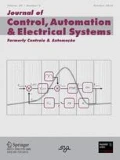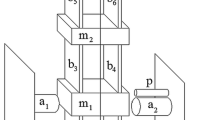Abstract
Flexible beams are parts of lighter structures and flexible manipulators, which possess numerous advantages. However, the flexibility leads to a vibration problem. This paper presents an experimental study of active vibration control of flexible beams. The beam assumed to behave according to the Euler–Bernoulli theory is modeled by a partial differential equation. The control objective is to suppress the vibration of the beam. Based on the Lyapunov stability theory of infinite-dimension systems, a control law is directly derived without using any approximated finite-dimensional model of the beam. The success of the controller is experimentally demonstrated on a cantilever aluminum beam with a laser displacement sensor and a piezoelectric actuator. Experimental results show that the controller effectively suppresses the vibration.




Similar content being viewed by others
References
Beer, F. P., Johnston, E. R., DeWolf, J., & Mazurek, D. F. (2014). Mechanics of materials. New York, NY: McGraw-Hill.
Chen, L.-X., & Sun, J.-Q. (2014). Multi-objective optimal design and experimental validation of tracking control of a rotating flexible beam. Journal of Sound and Vibration. doi:10.1016/j.jsv.2014.05.004.
Dadfarnia, M., Jalili, N., Xian, B., & Dawson, D. M. (2004). A Lyapunov-based piezoelectric controller for flexible Cartesian robot manipulators. Journal of Dynamic Systems, Measurement, and Control, 126, 347–358.
Dafang, W., Liang, H., Bing, P., Yuewu, W., & Shuang, W. (2014). Experimental study and numerical simulation of active vibration control of a highly flexible beam using piezoelectric intelligent material. Aerospace Science and Technology, 37, 10–19.
Feliu, V., Pereira, E., & Díaz, I. M. (2014). Passivity-based control of single-link flexible manipulators using a linear strain feedback. Mechanism and Machine Theory, 71, 191–208.
Fuller, C. C. (1996). Active control of vibration. San Diego, CA: Academic Press.
Gagg F, L. A., da Conceicao, S. M., Vasques, C. H., de Abreu, G. L. C. M., Lopes, V, Jr, & Brennan, M. J. (2014). Experimental identification and control of a cantilever beam using ERA/OKID with a LQR. Journal of Control, Automation and Electrical Systems, 25, 161–173.
Ge, S. S., Lee, T. H., Zhu, G., & Hong, F. (2001). Variable structure control of a distributed-parameter flexible beam. Journal of Robotic Systems, 18, 17–27.
Gosavi, S. V., & Kelkar, A. G. (2004). Modelling, identification, and passivity-based robust control of piezo-actuated flexible beam. Journal of Vibration and Acoustics, 126, 260–271.
Hu, Q. (2012). Robust adaptive sliding mode attitude control and vibration damping of flexible spacecraft subject to unknown disturbance and uncertainty. Transactions of the Institute of Measurement and Control, 34, 436–447.
Jnifene, A. (2007). Active vibration control of flexible structures using delayed position feedback. Systems and Control Letters, 56, 215–222.
Petersen, I. R., & Pota, H. R. (2003). Minimax LQR optimal control of a flexible beam. Control Engineering Practice, 11, 1273–1287.
Phan, V. P., Goo, N. S., Yoon, K.-J., & Hwang, D.-S. (2012). Lookup table control method for vibration suppression of a flexible manipulator with optimization of the minimum settling time and energy consumption. Asian Journal of Control, 14, 693–706.
Preumont, A. (2004). Vibration control of active structures. Dordrecht: Kluwer Academic Publishers.
Qiu, Z., Han, J., Zhang, X., Wang, Y., & Wu, Z. (2009). Active vibration control of a flexible beam using a non-collocated acceleration sensor and piezoelectric patch actuator. Journal of Sound and Vibration, 326, 438–455.
Shang, Y. F., Xu, G. Q., & Chen, Y. L. (2012). Stability analysis of Euler–Bernoulli beam with input delay in the boundary control. Asian Journal of Control, 14, 186–196.
Sharma, S. K., Sutton, R., & Tokhi, M. O. (2014). Local model and controller network design for a single-link flexible manipulator. Journal of Intelligent and Robotic Systems, 74, 605–623.
Xu, Y., & Ritz, E. (2009). Vision based flexible beam tip point control. IEEE Transactions on Control Systems Technology, 17, 1220–1227.
Author information
Authors and Affiliations
Corresponding author
Appendices
Appendix 1
The following inequalities are used in the subsequent derivation:
First, we derive the condition for \(\beta _0 \) such that \(V(t)>0\). By substituting
and
into Eq. (17), it gives
By using Eqs. (24) and (26), \(V_2 (t)\) which is given in Eq. (19) can be derived as
where \(\alpha _1 \) and \(\alpha _2 \) are positive constants. Then, by substituting Eqs. (28) and (29) into Eq. (21) and using Eq. (25), it yields
By setting
we obtain \(V(t)>0\). From Eq. (31), we have
To assure Eq. (32) which gives \(V(t)>0\), \(\beta _0 \) should be chosen as
Next, the condition which yields \(\dot{V}(t)<0\)is examined. By substituting Eq. (23) into Eq. (22), we have
Define
By using Eqs. (24), (25) and (35), it yields
where \(\alpha _3 \) is a positive constant. By setting
we obtain \(\dot{V}(t)<0\). Thus, \(\beta _0 \) and \(\alpha _3 \) should be chosen as
to guarantee \(\dot{V}(t)<0\). Therefore, according to Eqs. (33) and (38), \(\beta _0 \) should be chosen as
where \(\alpha _3 \) satisfies Eq. (39).
Note that the conditions (39) and (40) are achievable. For our experimental system (using numerical values form Table 1), we have \(\frac{EI_\mathrm{b} }{Cl^{2}}=9.8\). Thus, we can simply choose \(\alpha _3 =1\) to satisfy Eq. (39). Similarly, we have \(\frac{B}{8b_\mathrm{b} \rho _\mathrm{b} t_\mathrm{b} }=386\), \(\frac{EI_\mathrm{b} B}{8C^{2}l^{2}}=3,070\) and \(\frac{B}{\rho _{\max } +C}=665\). Thus, \(\beta _0 <386\) satisfies Eq. (40).
Appendix 2
To estimate \(g(t)\) from \(w(l,t)\), we considered only the first vibration mode of the beam. The deflection equation can be expressed as (Beer et al. 2014)
Taking its derivative with respect to \(x\) yields
From Eq. (41),
Substituting Eq. (43) into Eq. (42) yields
Thus, we have
Rights and permissions
About this article
Cite this article
Luemchamloey, A., Kuntanapreeda, S. Active Vibration Control of Flexible Beams Based on Infinite-Dimensional Lyapunov Stability Theory: An Experimental Study. J Control Autom Electr Syst 25, 649–656 (2014). https://doi.org/10.1007/s40313-014-0145-3
Received:
Revised:
Accepted:
Published:
Issue Date:
DOI: https://doi.org/10.1007/s40313-014-0145-3




